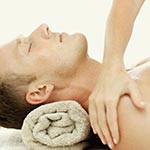Understanding the Pain Cycle
The pain cycle is a complex chain of events which reinforce each other. It can begin with injury, illness or even stress, but each element can trigger or amplify another, creating a self-perpetuating cycle.
Muscle Tension
Muscle tension from stress, repetitive activity or overuse can be painful. Tense muscles are prone to injury, adding to the problem. Worse, muscles automatically contract around any painful site to support and protect the area. If your original pain is not resolved, muscles may become habitually contracted. In this way, painful muscle tension can spread, even pressing on nerves to cause tingling, numbness and more pain in new areas.
Reduced Circulation
Like a sponge that is squeezed, a contracted muscle can’t hold much fluid. This means tight muscles suffer from reduced circulation. Irritating waste products can accumulate, leaving you feeling fatigued and sore.
Over time, areas with poor circulation form trigger points in both muscles and their connective tissue coverings, called fascia. Trigger points are highly irritable spots that can refer pain elsewhere in the body. For example, a trigger point in your hip can cause pain down your leg.
Pain and muscle tension can make even simple actions difficult. This impairs your ability to exercise – your most important means for maintaining mobility and good circulation throughout your body. Eventually, contracted muscles and fascia can develop areas called adhesions, where tissues “adhere” to each other, further restricting movement and contributing to your pain.
Breaking the cycle
 Massage Therapy can help break the cycle of pain with its ability to address most of the pain cycle elements. Using specific techniques massage can relieve muscle tension and release trigger points (see diagram opposite). Muscle stretching and improved circulation from massage can prevent their return.
Massage Therapy can help break the cycle of pain with its ability to address most of the pain cycle elements. Using specific techniques massage can relieve muscle tension and release trigger points (see diagram opposite). Muscle stretching and improved circulation from massage can prevent their return.
When muscles are relaxed this reduces pressure on nerves, relaxes the nervous system and promotes blood vessels to dilate and increase circulation. This in turn relieves related pain in distant sites.
Increased circulation flushes away irritating waste products and provides healing oxygen and nutrients.
Certain techniques increase the pliability of adhesions. Along with reduced muscle tension, this helps to restore normal movement and prevent new injuries.
What else should I do?
First and foremost, if you haven’t done so yet, see your Doctor. Especially if you are taking pain killers to get through the day.
Many people have found Acupuncture and Dry Needling to be beneficial for pain relief, supporting the adrenal glands and nervous system to function normally.
A Naturopath can provide you with nutritional advice and recommend herbal or nutritional supplements to speed healing and recovery. A Naturopath can also advise you on alternative options to pain killers that are still effective, but gentle on your digestive system and liver.
 Take back control of your health and let your body help you! Include massage as part of your pain relief therapy.
Take back control of your health and let your body help you! Include massage as part of your pain relief therapy.
Click here for more information on the benefits of Remedial Massage.

